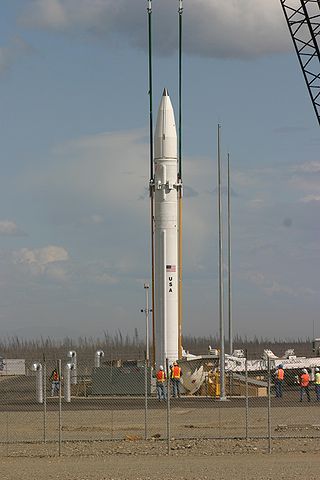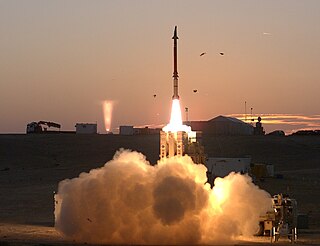
An anti-ballistic missile (ABM) is a surface-to-air missile designed to counter ballistic missiles. Ballistic missiles are used to deliver nuclear, chemical, biological, or conventional warheads in a ballistic flight trajectory. The term "anti-ballistic missile" is a generic term for a system designed to intercept and destroy any type of ballistic threat; however, it is commonly used for systems specifically designed to counter intercontinental ballistic missiles (ICBMs).

The AIM-120 Advanced Medium-Range Air-to-Air Missile(AMRAAM) ( AM-ram) is an American beyond-visual-range air-to-air missile capable of all-weather day-and-night operations. It uses active transmit-receive radar guidance instead of semi-active receive-only radar guidance. When an AMRAAM missile is launched, NATO pilots use the brevity code "Fox Three".
A monopropellant rocket is a rocket that uses a single chemical as its propellant. Monopropellant rockets are commonly used as small attitude and trajectory control rockets in satellites, rocket upper stages, manned spacecraft, and spaceplanes.

The Exoatmospheric Kill Vehicle (EKV) is the Raytheon-manufactured interceptor component with subcontractor Aerojet of the U.S. Ground-Based Midcourse Defense (GMD), part of the larger National Missile Defense system.

Ground-Based Midcourse Defense (GMD), previously National Missile Defense (NMD), is an anti-ballistic missile system implemented by the United States of America for defense against ballistic missiles, during the midcourse phase of ballistic trajectory flight. It is a major component of the American missile defense strategy to counter ballistic missiles, including intercontinental ballistic missiles (ICBMs) carrying nuclear, chemical, biological or conventional warheads.

Aerojet Rocketdyne is a subsidiary of American defense company L3Harris that manufactures rocket, hypersonic, and electric propulsive systems for space, defense, civil and commercial applications. Aerojet traces its origins to the General Tire and Rubber Company established in 1915, while Rocketdyne was created as a division of North American Aviation in 1955. Aerojet Rocketdyne was formed in 2013 when Aerojet and Pratt & Whitney Rocketdyne were merged, following the latter's acquisition by GenCorp, Inc. from Pratt & Whitney. Aerojet Rocketdyne was acquired by L3Harris in July 2023 for $4.7 billion.

The Skyflash, or Sky Flash in marketing material, was a medium-range semi-active radar homing air-to-air missile derived from the US AIM-7 Sparrow missile and carried by Royal Air Force McDonnell Douglas F-4 Phantoms and Tornado F3s, Italian Aeronautica Militare and Royal Saudi Air Force Tornados and Swedish Flygvapnet Saab Viggens.

The Missile Defense Agency (MDA) is a component of the United States government's Department of Defense responsible for developing a comprehensive defense against ballistic missiles. It had its origins in the Strategic Defense Initiative (SDI) which was established in 1983 by Ronald Reagan and which was headed by Lt. General James Alan Abrahamson. Under the Strategic Defense Initiative's Innovative Sciences and Technology Office headed by physicist and engineer Dr. James Ionson, the investment was predominantly made in basic research at national laboratories, universities, and in industry. These programs have continued to be key sources of funding for top research scientists in the fields of high-energy physics, advanced materials, nuclear research, supercomputing/computation, and many other critical science and engineering disciplines—funding which indirectly supports other research work by top scientists, and which was most politically viable to fund from appropriations for national defense. It was renamed the Ballistic Missile Defense Organization in 1993, and then renamed the Missile Defense Agency in 2002. The current director is Lieutenant General Heath A. Collins.
Aerojet was an American rocket and missile propulsion manufacturer based primarily in Rancho Cordova, California, with divisions in Redmond, Washington, Orange and Gainesville in Virginia, and Camden, Arkansas. Aerojet was owned by GenCorp, Inc., In 2013, Aerojet was merged by GenCorp with the former Pratt & Whitney Rocketdyne to form Aerojet Rocketdyne.

Hydroxylammonium nitrate or hydroxylamine nitrate (HAN) is an inorganic compound with the chemical formula [NH3OH]+[NO3]−. It is a salt derived from hydroxylamine and nitric acid. In its pure form, it is a colourless hygroscopic solid. It has potential to be used as a rocket propellant either as a solution in monopropellants or bipropellants. Hydroxylammonium nitrate (HAN)-based propellants are a viable and effective solution for future "green" propellant-based missions, as it offers 50% higher performance for a given propellant tank compared to commercially used hydrazine.

NASAMS is a short- to medium-range ground-based air defense system developed by Kongsberg Defence & Aerospace (KDA) and RTX Corporation. The system defends against unmanned aerial vehicles (UAVs), helicopters, cruise missiles, unmanned combat aerial vehicles (UCAVs), and fixed wing aircraft, firing any of a wide range of existing missiles.

The RIM-161 Standard Missile 3 (SM-3) is a ship-based surface-to-air missile used by the United States Navy to intercept short- and intermediate-range ballistic missiles as a part of Aegis Ballistic Missile Defense System. Although primarily designed as an anti-ballistic missile, the SM-3 has also been employed in an anti-satellite capacity against a satellite at the lower end of low Earth orbit. The SM-3 is primarily used and tested by the United States Navy and also operated by the Japan Maritime Self-Defense Force.

The RIM-174 Standard Extended Range Active Missile (ERAM), or Standard Missile 6 (SM-6), is a missile in current production for the United States Navy (USN). It was designed for extended-range anti-air warfare (ER-AAW) purposes, providing capability against fixed and rotary-wing aircraft, unmanned aerial vehicles, anti-ship cruise missiles in flight, both over sea and land, and terminal ballistic missile defense. It can also be used as a high-speed anti-ship missile. The missile uses the airframe of the earlier SM-2ER Block IV (RIM-156A) missile, adding the active radar homing seeker from the AIM-120C AMRAAM in place of the semi‑active seeker of the previous design. This will improve the capability of the Standard missile against highly agile targets and targets beyond the effective range of the launching vessels' target illumination radars. Initial operating capability was planned for 2013 and was achieved on 27 November 2013. The SM-6 is not meant to replace the SM-2 series of missiles but will serve alongside and provide extended range and increased firepower. It was approved for export in January 2017. An air-to-air variant of the SM-6, known as the AIM-174, is the first dedicated long-range air-to-air missile employed by the USN since the 2004 retirement of the AIM-54 Phoenix. SM-6 can also be fired from the U.S. Army's Typhon missile launcher as part of the Strategic Mid-range Fires System (SMRF).

The Multiple Kill Vehicle (MKV) was a planned U.S. missile defense program whose goal was to design, develop, and deploy multiple small kinetic energy-based warheads that can intercept and destroy multiple ballistic missiles, including possible decoy targets.

The AIM-9 Sidewinder is a short-range air-to-air missile. Entering service with the United States Navy in 1956 and the Air Force in 1964, the AIM-9 is one of the oldest, cheapest, and most successful air-to-air missiles. Its latest variants remain standard equipment in most Western-aligned air forces. The Soviet K-13, a reverse-engineered copy of the AIM-9B, was also widely adopted.

David's Sling, also formerly known as Magic Wand, is an Israel Defense Forces military system jointly developed by the Israeli defense contractor Rafael Advanced Defense Systems and the American defense contractor Raytheon, that became operational in 2017. It is designed to intercept enemy planes, drones, tactical ballistic missiles, medium to long-range rockets and cruise missiles, fired at ranges from 40 to 300 km. David's Sling is intended to replace the MIM-23 Hawk and MIM-104 Patriot in the Israeli arsenal.

The SLAMRAAM (Surface Launched AMRAAM) was the United States Army program to develop a Humvee-based surface-to-air missile launcher for the AIM-120 AMRAAM missile, manufactured by Raytheon Technologies and Kongsberg Defence & Aerospace. Surface-launched AMRAAM missile was first used in Kongsberg's NASAMS air defense system, fielded in 1995.

The Green Propellant Infusion Mission (GPIM) was a NASA technology demonstrator project that tested a less toxic and higher performance/efficiency chemical propellant for next-generation launch vehicles and CubeSat spacecraft. When compared to the present high-thrust and high-performance industry standard for orbital maneuvering systems, which for decades, have exclusively been reliant upon toxic hydrazine based propellant formulations, the "greener" hydroxylammonium nitrate (HAN) monopropellant offers many advantages for future satellites, including longer mission durations, additional maneuverability, increased payload space and simplified launch processing. The GPIM was managed by NASA's Marshall Space Flight Center in Huntsville, Alabama, and was part of NASA's Technology Demonstration Mission Program within the Space Technology Mission Directorate.

The Ground-Based Interceptor (GBI) is the anti-ballistic missile component of the United States' Ground-Based Midcourse Defense (GMD) system.

The Multi-Mission Launcher (MML) is an open-systems architecture multi-role missile launching system created by the United States Army's Aviation and Missile Research, Development, and Engineering Center.
















